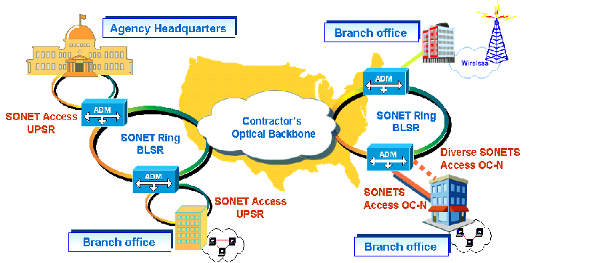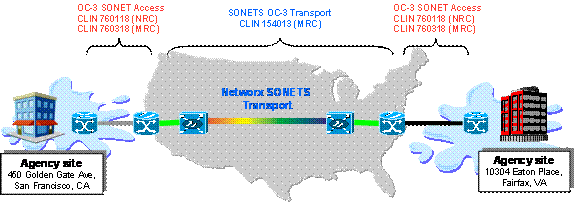SONETS is a Networx service that enables Agencies to build optical transport networks that are high bandwidth, with a high level of reliability and traffic isolation. These transport networks are built using facilities from the contractor's optical backbones. SONETS provides proactive performance monitoring and enables self-healing functions with robust network management.
SONET is the U.S. standard for fiber optic synchronous transmission rates from 51.84 Mbps (OC-1) to beyond 13.27 Gbps (OC-256). The International Telecommunications Union version of the standard is the Synchronous Digital Hierarchy (SDH), which begins at 155 Mbps. SONETS is capable of interoperating with SDH in CONUS by providing gateway functions to transport SDH traffic over a SONET infrastructure.
The diagram below illustrates a CONUS wide optical transport network built over a contractor's optical backbone that interconnects Agency's headquarters with branch offices. The Agency's optical network depicted is able to deliver bandwidth via electrical User to Network Interfaces (UNIs) i.e. DS1, DS3, E1, E3 and optical carrier (OC) interfaces i.e. OC-3 up to OC-192.
The contractor's optical backbone in the example below is built by multiple SONET rings designed with two different protection methods (e.g., UPSR, BLSR). The core rings use Bidirectional Switched Ring (BLSR) protection and the metro/access rings uses Unidirectional Path Switched Ring (

Example SONETS Implementation
SONETS may be ordered in Metro areas or long haul CONUS wide, with OCONUS and Non-Domestic locations optional to offer. As specified in Section C.2.5.2.1.3 of the Networx contracts, the Agency can order SONETS that will connect to and interoperate with:
Basic SONETS is a point-to-point bi-directional, single link service. Private networks with more complex topologies such as rings and mesh can also be provided with Next Generation SONETS capabilities.
SONETS transport technologies have evolved from a strict Time Division Multiplexing (TDM) channel allocation to more flexible bandwidth allocation methods provided by Next Generation SONET technologies. These include Link Adjustment Capacity Scheme (LCAS), Generic Framing Procedure (GFP) and Virtual Concatenation (VCAT). Basic SONET has always enabled Agencies to interconnect dissimilar networks such as Asynchronous Transfer Mode (ATM), Frame Relay (FR), and IP. However, with the additional protocols supported by Next Gen SONET (LCAS, GFP and VCAT), bandwidth efficiency has been considerably improved.
Agencies subscribing to SONETS may opt for a single connection point-to-point which will be a dedicated connection between two sites with a dedicated, built-in protection channel that will not be used by any other customer's traffic. The Networx contractors support other network topologies such as rings and mesh. More detailed descriptions of SONETS capabilities are provided in Section C.2.5.2.1.4 of the Networx contracts.
SONETS features that may be orderable are detailed in Section C.2.5.2.2.1 of the Networx contracts and are listed below:
Each Networx contractor may provide variations or alternatives to the offering and pricing for SONETS. The specific details can be found within each Contractors Networx contract files and pricing notes for SONETS.
For more information on the general SONETS specifications and requirements, please refer to Section C.2.5.2 of the Networx contract for technical specifications and Section B.2.5.2 for pricing.
SONETS is highly reliable transport that provides proactive performance monitoring thus preventing single and multiple failures, and further enables self-healing functions and robust network management. SONETS is a service that was not offered on the original FTS2001 contracts. SONETS is available as:
The MRC for transport consists of a fixed component plus a distance-dependent (per mile) component. The mileage charge for SONETS transport is based on the total mileage between the contractor's designated connecting POPs for any two customer locations. CONUS-to-CONUS distance is calculated using the distance formula:
Distance involving OCONUS or non-domestic locations is calculated using airline miles. Note: The Networx Pricer automatically calculates the distance when given the originating and terminating locations.
Price components required for full end-to-end service for Domestic and Non-Domestic FB SONETS:
Example 1: Domestic SONETS FB OC-3

Each Networx contractor may provide variations or alternatives to the offering and pricing for SONETS. The specific details can be found within each Contractors Networx contract files and pricing notes for SONETS.
For more information on the general SONETS specifications and requirements, please refer to Section C.2.5.2 of the Networx contract for technical specifications and Section B.2.5.2 for pricing.